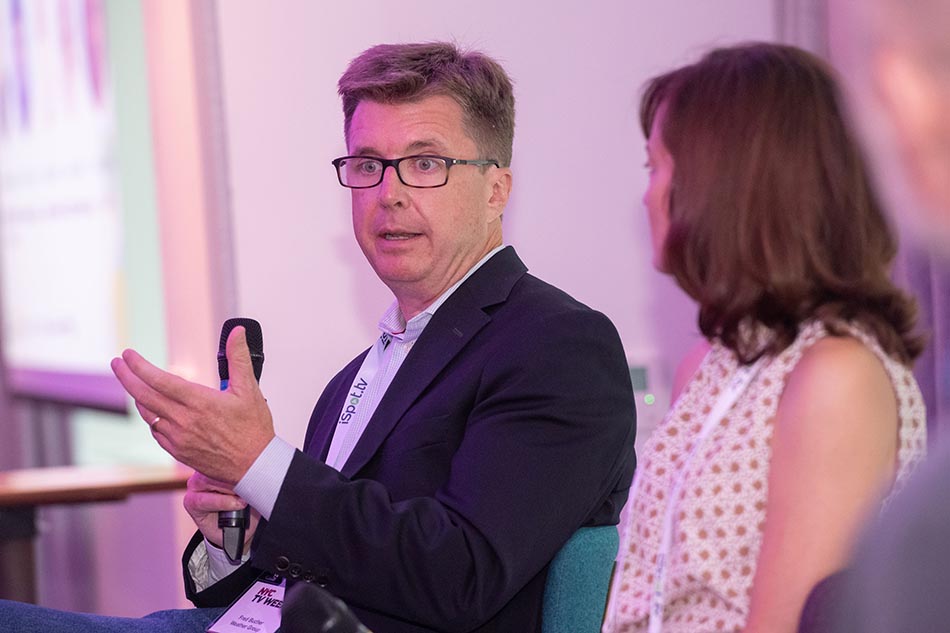Next TV Summit: Streaming Looks to Bundles to Attract Subs
As economy creates more price-conscious consumers, panel says bundling and content aggregation could be the answer for streamers

With streaming video companies looking for ways to stem the slowdown in subscriber growth, a panel of experts at the Next TV Summit said using an old cable tenet — bundling — could help attract more price-conscious consumers into the fold.
At the “Recession Realities” panel at the gathering Tuesday, part of NYC TV Week, Weather Group senior VP and chief marketing officer Fred Bucher said the same economic forces and price sensitivity that killed the cable bundle are apparently making a comeback with streaming. Already streamers like Disney, with its Hulu, ESPN Plus and Disney Plus bundle, and others are repackaging services to make them more attractive to consumers.
“Economic forces and price sensitivity is what killed the cable bundle, and that’s continuing,” Bucher said, adding that price sensitivity and churn are driving the creation of different tiers of pricing and services like ad-supported video-on-demand (AVOD) and free ad-supported streaming television (FAST) services.
Weather Group launched its own streaming service — Local Now — to address cord-cutters who missed local news and entertainment content.
“A lot of the answers for the future are in the past,” Bucher said, adding that what built the cable business — aggregation, better pricing and bundling — will likely be cornerstones of SVOD and AVOD models in a few years.
Panel moderator Jon Geigengack, founder and principal of Hub Entertainment Research, said that as the bundle grows, consumers will crave a way to make finding content easier, and aggregation is one way to satisfy that need.
DirecTV Advertising Group VP, client success, programmatic and ad operations Rose McGovern agreed, adding that aggregation is what DirecTV does best. Citing recent Nielsen research, she said about 64% of customers wish to have a bundle that includes as much or as little content as they want.
NEXT TV NEWSLETTER
The smarter way to stay on top of the streaming and OTT industry. Sign up below.
That includes live and local programming as well, McGovern added, with about 67% of people nationally watching live content every day.
As content streaming choices grow, Bucher said it is imperative that content companies get the word out, and that means marketing becomes more important than ever.
“The biggest threat is underinvestment in marketing,” Bucher said. “It starts with great content, great product experience, and great marketing. If you don’t have those three things, you’re not going to win.”

Bucher added that critical to the marketing effort is that streamers really know their consumers.
“You have to understand who your consumers are, understand who your hard core users are too and make them happy,” Bucher said.
And once you’ve hooked a viewer, the trick is keeping them. At AMC Networks, executive VP of performance marketing Sylvia George said engagement is a critical part of the equation.
“What is so critical is your audience,” George said. “The relationship with the audience, super-serving the audience, making sure that you’re segmenting your audience based on data, based on what is your audience engaging with once they come in — not just the first thing they watch, what’s the second and third thing they watch. Getting people engaged within a specific time period is critical to ensuring retention. If you don’t get your subscriber engaged within a few weeks, you’re at risk of losing them. You can’t get complacent.”
The panel also was encouraged by Netflix’s plan to launch an ad-supported version of the service soon. The company has already partnered with Microsoft to provide the tech infrastructure for the AVOD service.
“In some ways, they could help re-energize the advertising business,” Bucher said, adding that Netflix doesn’t have the “institutional inertia” of some other companies that have long been in the ad business. “It’s kind of cool to take a fresh look.”
Bucher was especially encouraged by the vast amount of data in Netflix's arsenal, adding that the ad business may never get this chance again.
McGovern also was encouraged by the potential for more innovation that a Netflix AVOD product could bring. For example, a departure from the traditional 15-second to 30-second ad spot.
But Bucher warned that whatever comes out of the Netflix AVOD experiment will depend on outside pressures.
“There’s a lot of stuff they could do that could be an enormous amount of fun… but what it’s going to come down to will be how much pressure they’re under to deliver a number of revenue,” Bucher said. “If there are huge revenue expectations, that’s going to diminish innovation, because they are going to default to what they know, and agencies will say, ‘Just make it easy for me.’ That, to me, will be a shame.
“The irony is that Reed Hastings, who was so dogmatic for so long about advertising, can actually become the person to really reinvent the space,” Bucher continued. “I hope they’re given the time to do that. “ ■
Mike Farrell is senior content producer, finance for Multichannel News/B+C, covering finance, operations and M&A at cable operators and networks across the industry. He joined Multichannel News in September 1998 and has written about major deals and top players in the business ever since. He also writes the On The Money blog, offering deeper dives into a wide variety of topics including, retransmission consent, regional sports networks,and streaming video. In 2015 he won the Jesse H. Neal Award for Best Profile, an in-depth look at the Syfy Network’s Sharknado franchise and its impact on the industry.

